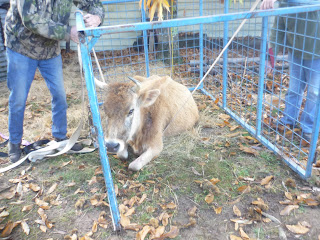Hailey the Jersey house cow is a bit on the small side. Apparently we weaned her too soon after we picked her up from a dairy farm at one and a half days old. Now she is four years old and heavily pregnant with her second calf. After her last calf we milked her for fourteen months before drying her off. She hadn't become pregnant so it was back to the start. Eight and a half months later she is heavy and weak from the weight of her Hereford calf and from living in poor paddocks. Our very dry summer and autumn have taken their toll and her daily feed of grain, chaff and beef nuts have not been enough for her.
So last night she had a big feed of lucerne hay and sat down to rest. Then, for the first time in ages, it poured. Hailey became cold, wet and tired. By the morning she couldn't rise and the weight of her calf on her back legs sent them to sleep. She had a few attempts to rise but with no success.
When I found her this morning she couldn't stand. I consulted my brains trust of local cattle producers and they all told me that she must get up today or her legs would never recover.
The pressure was on, literally. First we tried some molasses to get her sugar level up and give her some energy. Then we applied a 'flopack' - an intravenous injection of calcium, glucose, magnesium and phosphorous. These are available from the local feedstore and should be stored in the fridge. The one we used was eight years out of date but it was all we had. The bag has to brought up to body temperature by immersing in a bucket of hot water. Once warm enough it is injected into the subcutaneous fat in several places, but mainly in the neck or ribs area.
She still didn't rise, but we were advised to allow two hours for the pack to work its magic. We also needed to administer a second one in about three to four hours. Being a Saturday afternoon our local supplier was closed but by a miracle the manager called into the office just as I rang on spec. He would leave a fresh Flopack at the cafe over the road and charge it to me on Monday. Luck and local knowledge was on my side. A quick dash into town and I was ready for the next attempt.
First we took the crate off the stock crate and carried it over to where she lay. Then we passed straps under her body behind her forelegs and in front of her back legs. These were tied to the crate on one side and to a ratchet tie-down strap or winch on the other. We slowly raised her to her feet but she was not helping and remained weak-legged. A third strap behind her hips helped get her up onto her back legs and a fresh strap on the front finally got her high enough.
By this time it was dark and under headlights we encouraged her to put her weight on her feet which finally she did. We then put the door back on the crate and administered the fresh flopack into both side of her neck. For about twenty minutes she stood still on her legs and we gradually eased off the pressure on the straps. After completely loosening them we gave her ten minutes more before we opened the gate and led her out.
An hour earlier we had nearly given up but she was up on her feet and walking about. I led her into her paddock and under the trees where some lucerne hay and a water trough awaited her. Half an hour later she was still on her feet. Hopefully she will be walking in the morning and the crisis will be over. Lessons learnt in keeping up the nutrients and the molasses while in late pregnancy. Many thanks to our wonderful neighbours who helped with advice, straps and winches.


No comments:
Post a Comment